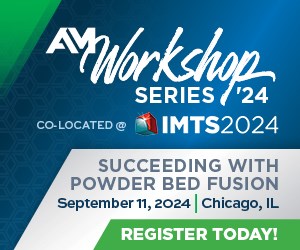3D Printers, Laser Welders Target Mold Production, Repair
IMTS 2024: Trumpf introduces a larger version of the TruPrint 2000 3D printer, as well as automated arc welding, laser welding and 3D laser marking technologies, noted for their use in tool and die.
Trumpf Inc. highlights the TruPrint 2000, which now features a larger, square build plate and is designed for more productive, reliable and high-quality 3D printing of tool steels like maraging steel, crucial in tool and die manufacturing.
Optimized for serial production, the TruPrint 2000 can offer greater productivity and quality. The system comes with a 300-watt laser in the basic configuration and is available with increased power from an optional 500-watt integrated fiber laser. The TruPrint is designed for simple and safe powder handling, and the combination of laser power, build volume and coating time is said to create an economical machine for series production. Trumpf’s additive manufacturing (AM) booth features a virtual showroom for participants to take a dive into the variety of laser technology and AM applications offered by Trumpf and to help determine the right equipment for different application and part requirements.
In its booth, Trumpf also showcases its automated arc welding, laser welding and 3D laser marking technology. On display is the TruArc Weld 1000 automated arc welding system for high-mix, low-volume production; the compact TruLaser Station 7000 fiber laser welding system; and TruMark Station 7000 with a TruMark 6030 marking laser for 3D laser marking.
According to the company’s website, its laser welding provides several benefits when used to repair mold and dies, including precision (producing distortion-free workpieces and welding with little to no rework), flexibility (portability enables operators to reach almost any feature of a mold, even large ones), durability and faster repairs.
Related Content
-
It Starts With the Part: A Plastic Part Checklist Ensures Good Mold Design
All successful mold build projects start with examining the part to be molded to ensure it is moldable and will meet the customers' production objectives.
-
Treatment and Disposal of Used Metalworking Fluids
With greater emphasis on fluid longevity and fluid recycling, it is important to remember that water-based metalworking fluids are “consumable” and have a finite life.
-
Laser Welding Versus Micro Welding
The latest battle in finely detailed restoration/repair of mold materials.









.jpg;maxWidth=300;quality=90)




